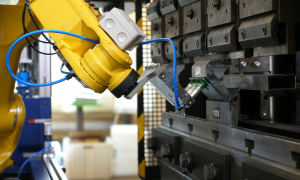4.6% of Lithuanian Companies Have Been Robotized: Can We Call That a Breakthrough?
Statistics Lithuania has calculated that the number of Lithuanian companies using robots has increased from 3.2 to 4.6% in two years. Looking at the numbers, it is difficult to talk about the promising breakthrough, but experts say that, although not fast enough, Lithuanian business is digitizing, and 1.4% growth is not as modest as it may look like.
The last time robots at Lithuanian companies were counted by Eurostat. Based on these data collected in 2018, Lithuania was one of the least robotized countries in Europe.
What has changed?
At the beginning of this year, when the number of robots was counted by the Department of Statistics, it was announced that, at the beginning of the year 2020, 4.6% of companies with more than 10 employees used robots, compared to 3.2% two years ago (no data were collected in 2019).
First of all, it is observed that, although the increase in the share of robotic companies from 3.2% to 4.6% does not appear to be significant, it in fact means that the number of companies using robots has increased by 30%.
“In the leading countries, the growth rates are consistent and fluctuate between 20-40%,” notes E. Tauraitė-Kavai. The context of time is also important.
“The main challenge for robotics is the digitization processes that enable it. If you have a simple production line and want to robotize it, you have to automate it first, then all the processes have to be digitized, connected to the system and only then can robotization be performed,” says the expert. She notes that many industrial companies in Lithuania are already automated, and we also look good in terms of the scale of digitization.
Let’s calculate
Justinas Katkus, co-founder of Factobotics (member of the Lithuanian Robotics Association), which offers robotics solutions to the industry, also invites to calculate. When counting robots in companies, Statistics Department only surveyed economic entities with more than 10 employees – 5,204 industrial enterprises and 8,403 service enterprises.
In general, only 12.7%, or 13,607, of all Lithuanian companies can be robotized, because all others are micro-enterprises," says J. Katkus. This means that in 2018, 435 Lithuanian companies had robots. At the beginning of 2020, - 626. "191 companies were robotized in two years. The tendency is good - Lithuania is digitizing.
The ball is on the business side
According to one of the founders of Factobotics, the speed of robotization in Lithuania is much too slow. E. Tauraitė-Kavai says that the main challenges are not due to robotics specialists, but due to the specifics of the industrial sector – low wages, low production volume and outsourced production, which creates less added value, still prevail here. “As a result, the motivation to robotize is low, as it would not significantly reduce costs and payback would be slow, and in the short term competitiveness may even decrease,” says the MITA expert.
Remigijus Laurutis, the head of the robotics company Nord Robotics, who was recently interviewed by VŽ, also said that although the demand for robots in Lithuanian companies is growing, businesses, especially the food industry, still need to be persuaded to robotise.
191 companies were robotized in two years. The tendency is good - Lithuania is digitizing.



